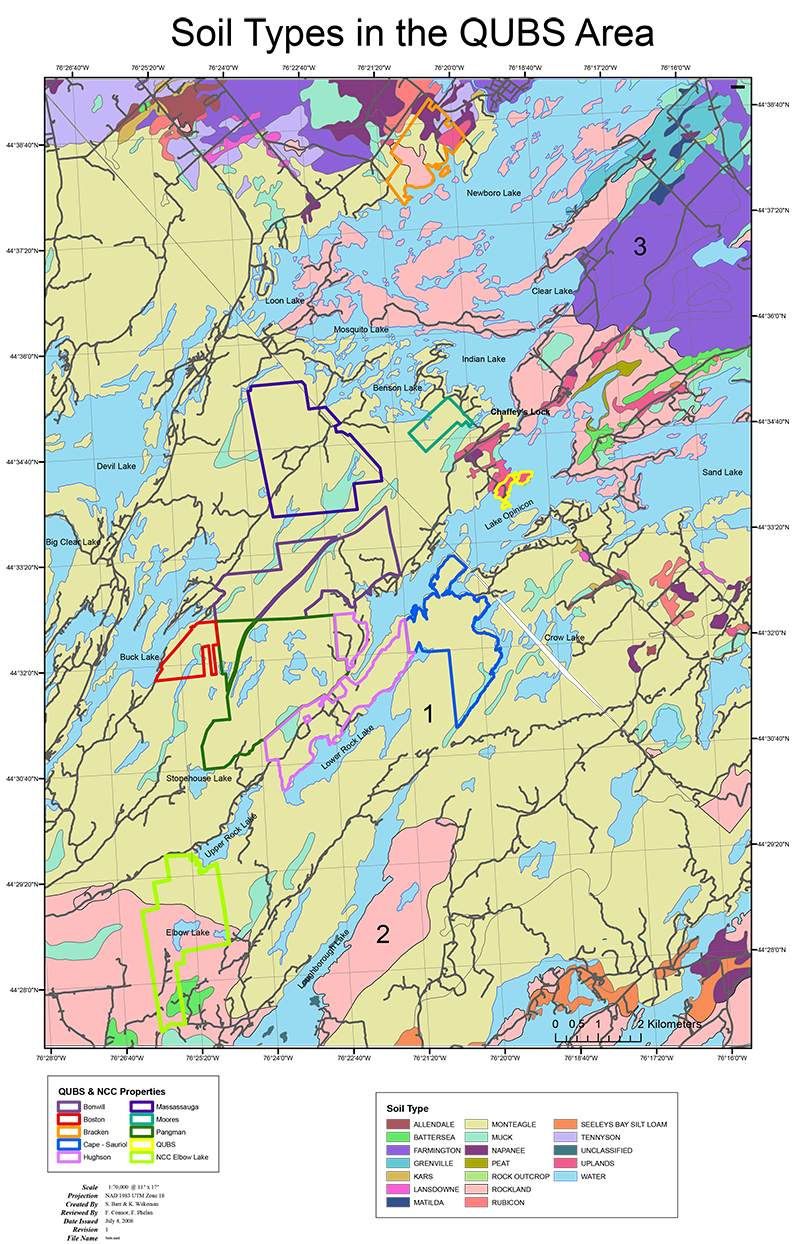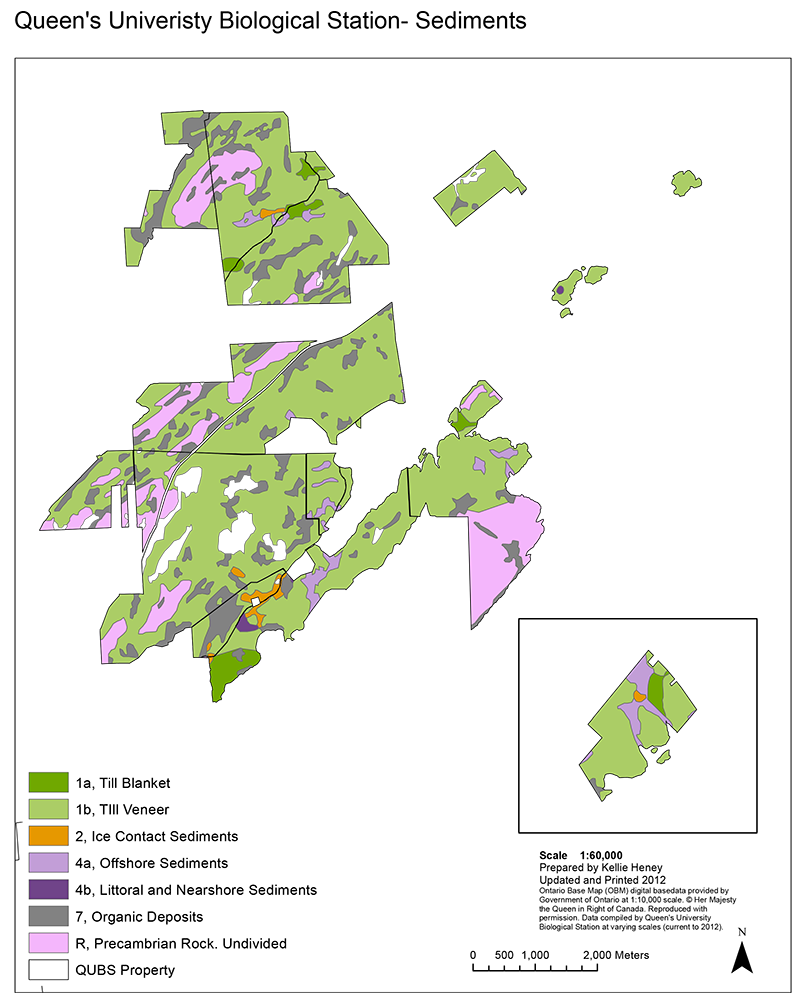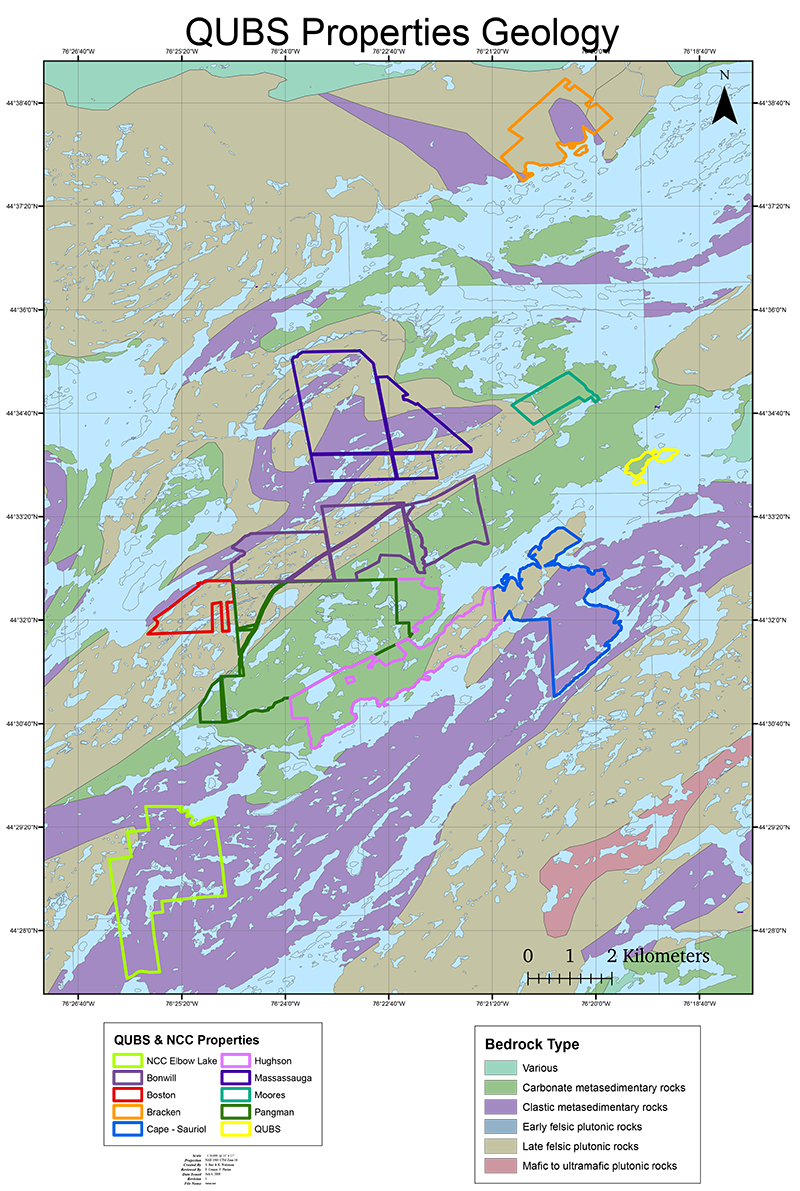Physical Geographic Map Resources for QUBS
Below we provide a series of pdf maps of various physical aspects (soils, bedrock, eventually hydrology) station's holdings. The thumbnail image will provide you with some notion of what each file presents. Click on the accompanying link to download a high-resolution pdf file. We also provide an article by Queen's professor Paul Grogan on the soils and vegetation of QUBS.
|
Soils of QUBS (pdf, 980 KB) |
Sediments of QUBS (pdf, 221 KB) |
|
Soils and Vegetation in the QUBS region
Paul Grogan
Department of Biology, Queen’s University, Kingston, ON Canada K7L 3N6
Email: groganp@queensu.ca
The Queen’s University Biological Station has several distinct landholdings within Frontenac and Leeds counties in southeastern Ontario (click here for details). This region contains a variety of soils ranging from very shallow, acidic, well-drained sandy loams through to moderately deep, calcareous, poorly drained clays. The vegetation of the region is classified within the Mixedwood Plains ecozone where agriculture is a major land-use (Wiken 1996). Mixed coniferous-deciduous forest is common, as are successional shrub communities in lands that have been abandoned from agriculture, and wetlands (Crowder et al. 1996). Finally, the region contains several alvars which support a distinctive flora that is characteristic of seasonally dry environments associated with very shallow soils on the edges of limestone plains (Crowder et al. 1996).
What are the principal factors contributing to variation in soil-types across the region?
a) Geology. The northern part of the region is composed primarily of Precambrian Canadian Shield granites and gneisses with some inclusions of metamorphosed sedimentary rocks such as crystalline limestone. By contrast, younger (Ordovician) limestone rocks generally underly the soils of the southern part of the region (Corlett 1986). More detailed geological descriptions indicate a scattered mosaic of differing bedrocks including granites, gneisses, granulites, sandstones and limestones within 15 km of QUBS (Wynne-Edwards 1967). Nevertheless, at the broadest scale, sandy soils tend to overly the Canadian Shield and clays and loams overly the southern part of the region.
b) Post-glacial history. Events during and after the most recent glaciation which ended ~10,000 years ago have had a profound impact on the landforms and associated surficial deposits of the region (Anonymous 2003; Corlett 1986). The harder Canadian Shield rocks resisted the grinding action of the glaciers to a greater degree than the softer sedimentary rocks to the south (Gilbert 1994). Furthermore, the glaciers in this region generally advanced in a southwesterly direction, moving eroded material off the Shield and on to the limestone (Corlett 1986). As a result of the glaciers and their meltwaters, patches of tills and other sediments such as glaciofluvial sand and gravel are scattered widely across the region (Anonymous 2003; Gilbert 1994), and moraines, drumlins and eskers are found to the south. Finally, large water bodies such as glacial lake Iroquois and the later connection to the Champlain sea resulted in substantial lacustrine and marine silt and clay deposits in the southeast of the region (Gilbert 1994). In theory, the markedly different physical and chemical properties of the Canadian Shield and limestone bedrocks would be expected to strongly influence soil development, and may well do so when directly adjacent to bedrock that is exposed above the post-glacial deposits (Curtis 1946). In practice however, development of the different soil-types across much of the region has been much more strongly influenced by the patchy distribution of underlying post-glacial surficial deposits than by bedrock-type.
c) Land-use history. Human impacts on soils of the region are likely to have been substantial. European colonization began in the 1780s (Gillespie et al. 1966; Osborne 1978) and was initially focused on the southern limestone plains close to the edge of Lake Ontario. The mature forests that would have covered most of the region at that time were logged and cleared for agriculture (Keddy 1993). These actions, and deliberate burning to produce potash fertilizer (Osborne 1982), would undoubtedly have resulted in soil losses via erosion as well as changes in soil biogeochemical properties and destruction of soil horizons (Foote & Grogan 2010). The lack of roads northward restricted initial movement of settlers on to the agriculturally less favorable Canadian Shield surfaces (Barber & Fuchs 1997; Osborne 1978). However, continuing population growth and demand for new farmland in the 1850s pushed settlers to clear the flatter and less rocky tracts of these lands for agriculture (Osborne 1982), while the more rocky areas were logged to provide wood for building construction, fuel, and export down the Rideau and other rivers (Osborne 1978). Logging and clearance were so intense across Eastern Ontario that most townships had <30% forest cover by 1880, and wood was apparently so scarce by 1900 that many townhouses were heated primarily by coal (Keddy 1993). Rural populations peaked around 1881, after which an ongoing pattern of abandonment of agricultural land began (Gillespie & Wicklund 1968; Osborne 1978) that continues to this day. In summary, many of the soils in the region are likely to have been significantly affected by the initial land clearance and then by subsequent agricultural practices. The more productive soils remain affected and are primarily in the southern parts of the region (Gillespie & Wicklund 1968; Gillespie et al. 1966), whilst the soils in abandoned lands are in a state of slow recovery as the vegetation naturally regenerates back toward mature forests (Foote & Grogan 2010).
In what ways do the soils influence the region’s natural vegetation?
Mature forests in the area are generally dominated by sugar maple (Acer saccharum Marsh.) and red oak (Quercus rubra L.) with some white oak (Quercus alba L.), red maple (Acer rubrum L.), basswood (Tilia americana L.), eastern hemlock (Tsuga canadensisL.), white pine (Pinus strobus L.), ironwood (Ostrya virginiana (P. Mill) K. Koch), and blue beech (Carpinus caroliniana Walt.) (Ecological Stratification Working Group 1995; Wiken 1996). In accordance with the climatic gradient toward the boreal zone, the coniferous component tends to increase in dominance in the northernmost parts of Frontenac and adjoining counties (Beschel et al. 1962). However, proximity to Lake Ontario modulates the climate within South Frontenac and Leeds counties, resulting in a mild north-south temperature gradient (Gillespie et al. 1966). The composition and productivity of the forest vegetation within this area do not broadly correlate with climatic or geological patterns (Beschel et al. 1962). Instead, it would appear that variations in soil properties and in land-use histories have been the primary determinants of the current vegetation distribution (Crowder et al. 1996).
The capacity of the soil-types in this area to hold and supply moisture seems to strongly influence both vegetation productivity and composition. This capacity is related to two properties: soil depth and soil texture. Relatively deep and fine-grained soils generally hold more water, and support relatively high plant growth rates. For example, the Luvisol soils of Wolfe and Howe Islands are the most agriculturally productive in Frontenac county and are used primarily to grow hay, oats, and to a lesser extent corn to support the livestock industry (Gillespie et al. 1966). Larger scale studies of the whole northern Great Lakes region also indicate that the distributions and relative abundances of the major forest plant species is determined primarily by variability in soil moisture rather than climate or geology (Maycock & Curtis 1960).
The water holding capacities of soils across the region vary substantially at several spatial scales because of strong heterogeneities in both soil depth and soil texture. At the landscape scale, topographical depressions in a watershed tend to accumulate greater depths of post-glacial deposits and soil organic materials. Precipitation inputs also accumulate in depressions on the landscape, resulting in moist conditions especially if the underlying bedrock is Canadian Shield and therefore poorly drained. However, even at scales of 10-100 m, strong spatial heterogeneity in both soil texture and depth have been observed within hayfields on the Canadian Shield (Crowder & Harmsen 1998), presumably as a result of small-scale patchiness in glacial and post-glacial deposits. Such heterogeneities lead to substantial variation in vegetation composition. For example, Rumex spp. are much more prevalent in sandy well-drained than in clay-dominated patches of hayfields on the Shield (Grogan, pers. obs.).
The composition and productivity of vegetation in the region is probably also strongly influenced by the supply of nutrients from soil. Nutrient availability to plants undoubtedly varies due to the differences in soil moisture described above that would affect rock weathering and soil biogeochemical cycling. In addition, chemical composition of bedrock and surficial deposits may be important. Phosphate and mica mines are scattered across the Shield area, presumably modifying local nutrient availability. Soil pH may also influence the supply of nutrients to plants. The distribution of certain calciphilic plant species in the region is clearly related to exposed limestone (e.g. alvars). However, just as for texture, soil pH is highly variable at small spatial scales (Grogan, pers. obs.), and often unrelated to the chemical composition of the underlying bedrock (Foote & Grogan 2010).
Soil fauna may also influence vegetation structure and productivity. For example, earthworms generally enhance nutrient cycling, and are frequently observed in soil cores from forests and fields throughout the region (Foote & Grogan 2010). However, populations of the invasive nightcrawler earthworm (Lumbricus terrestris, L.) are spreading within the region. This earthworm species in particular tends to move litter from the ground surface down into deeper soil layers, thereby changing the forest floor environment (Bohlen et al. 2004). Recent studies in mature forests of the QUBS region indicate infrequent surface litter layer cover (Foote & Grogan 2010), leading to the concern that understory plant species germination and tree seedling survival may be adversely affected.
What other factors influence the region’s natural vegetation?
Herbivory by animals such as white-tailed deer, beavers and meadow voles undoubtedly have substantial impacts on the region’s vegetation (Brdar, pers. comm.; Grogan, pers. obs.;Cote et al. 2004; Horsley et al. 2003). Furthermore, fluctuations in deer and beaver population numbers associated with eradication of predators (e.g. wolves) as well as varying intensities of hunting and trapping over the past two centuries have probably had strong impacts on vegetation development. Wildfires have also been an ongoing feature of the region, influencing local vegetation succession, and promoting blueberry heath and Jack pine stands in particular.
The importation of alien (mostly Eurasian) invasive species is altering the composition and structure of the region’s vegetation. Eurasian grasses and weeds are very common in roadside and agricultural areas. Mature forests outside Kingston seem to be largely unaffected so far, but nevertheless are clearly threatened by potential invasions of tree species such as European buckthorn (Rhamnus cathartica L.),vines (e.g. Vincetoxicum and Cynanchum spp.), and herbs such as Garlic mustard (Alliaria petiolata L.). Furthermore, several imported fungal pathogens and insect pests such as Dutch elm disease and Emerald ash borer can have severe impacts on certain native tree species, thereby altering forest vegetation composition.
Finally, airborne pollutants such as acid rain and atmospheric nitrogen deposition are likely to have influenced both vegetation and soils of the region over the past ~50 years.
What specific soil-types are present within the QUBS landholdings?
The following characterizations are based on the Ontario Soils Survey maps (Gillespie & Wicklund 1968; Gillespie et al. 1966), but do not encompass the substantial small-scale variation described above.
Bracken tract: Clays (Napanee series – Humic gleysol); Sandy loams (Monteagle and Tennyson series – Gray-Brown podsol); Upland sands (Podsol)
Massassauga property: Sandy-loam (Monteagle series – Gray-Brown podsol); Wetland peat (Muck – Organic)
Opinicon road properties: Sandy-loam (Monteagle series Gray-Brown podsol); Wetland peat (Muck – Organic); Uplands sands (Podsol). More detailed soil studies directly around the station including Cow island (where the eastern part is underlain by sandstone, while the western part is crystalline limestone) clearly demonstrate strong small-scale variation in soil horizon structure and nutrient contents (Curtis 1946).
Useful resources
- Soils surveys of Frontenac County and Leeds County
- Bedrock geology map of Southern Ontario
- Williams, D.A. and Wolf R.R. 1984. Paleozoic geology of the Westport area, southern Ontario; Ontario Geological Survey, Preliminary Map P.2723, scale 1:50 000.
- Local geology field trip guide
- Queen's University aerial photo database
Acknowledgements
Thanks to Adele Crowder, Dolf Harmsen, Dale Kristensen and Floyd Connor for comments on a previous version of this document.
Bibliography
- Anonymous (2003) Surficial Geology of Southern Ontario. Miscellaneous Release Data : 128. . Ontario Geological Survey, Ministry of Northern Development and Mines, Queen’s Printer for Ontario,
- Barber C & Fuchs T (1997) The Enduring Spirit. The History of Frontenac Provincial Park 1783-1990. Quarry Press, Kingston, Ontario
- Beschel RE, Tippett R & Webber PJ (1962) Woodland Transects of Frontenac Axis Region, Ontario. Ecology 43: 386-&
- Bohlen PJ, Scheu S, Hale CM, McLean MA, Migge S, Groffman PM & Parkinson D (2004) Non-native invasive earthworms as agents of change in northern temperate forests. Frontiers in Ecology and the Environment 2: 427-435
- Corlett M (1986) Geology of Eastern Ontario. Bluebird 33: 48-56
- Cote SD, Rooney TP, Tremblay JP, Dussault C & Waller DM (2004) Ecological impacts of deer overabundance. Annual Review of Ecology Evolution and Systematics 35: 113-147
- Crowder A & Harmsen R (1998) Notes on forest succession in old fields in southeastern Ontario: the woody species. Canadian Field-Naturalist 112: 410-418
- Crowder A, Topping KEJ & Topping JC (1996) Plants of the Kingston Region. The Fowler Herbarium, Queen’s University, Kingston
- Curtis C (1946) The soils of the Queen’s University Biological Station. Biology. Queen’s, Kingston
- Ecological Stratification Working Group (1995) A national ecological framework for Canada. (p 125). Agriculture and Agri-Food Canada, Research Branch, Centre for Land and Biological Resources Research and Environment Canada, State of the Environment Directorate, Ecozone Analysis Branch, Ottawa
- Foote R, Grogan P (2010) Soil carbon accumulation during temperate forest succession on abandoned low productivity agricultural lands. Ecosystems 13:795-812.
- Foote RL & Grogan P (2007) Soil carbon and nitrogen dynamics along replicated chronosequences of abandoned agricultural lands in southeastern Ontario. Biology. Queen’s, Kingston
- Gilbert R (Ed) (1994) A Field Guide to the Glacial and Postglacial landscape of southeastern Ontario and part of Quebec. Geological Survey of Canada,
- Gillespie JE & Wicklund RE (1968) Soils of Leeds County. Ontario Soil Survery. Ontario Department of Agriculture and Food and Canada Department of Agriculture, Ottawa
- Gillespie JE, Wicklund RE & Matthews BC (1966) Soil survey of Frontenac county. Ontario soil survey (p 67). Ontario Department of Agriculture and Food and Canada Department of Agriculture, Ottawa
- Horsley SB, Stout SL & DeCalesta DS (2003) White-tailed deer impact on the vegetation dynamics of a northern hardwood forest. Ecological Applications 13: 98-118
- Keddy C (1993) Forest History of Eastern Ontario. Report Number 2.1/93. Ministry of Natural Resources, Brockville, Ontario
- Maycock PF & Curtis JT (1960) The Phytosociology of Boreal Conifer Hardwood Forests of the Great Lakes Region. Ecological Monographs 30: 2-35
- Osborne BS (1978) Frontier settlement in Eastern Ontario in the nineteenth century: A study in changing perceptions of land and opportunity. In: Miller DH & Steffen JO (Eds) The Frontier: Comparative studies. University of Oklahoma, Norman
- Osborne BS (1982) The Farmer and the Land. In: Rollason B (Ed) County of a Thousand Lakes. Kingston
- Wiken EB (1996) Ecozones of Canada. Environment Canada, Ottawa
- Wynne-Edwards HR (1967) Westport map-area, Ontario, with special emphasis on the Precambrian rocks. Memoir 346. Geological Survey of Canada.
Reviewed by:
Dolf Harmsen (Queen’s University), Adele Crowder (Queen’s University), Dale Kristensen (Queen’s University) and Floyd Connor (Queen’s University Biological Station)



